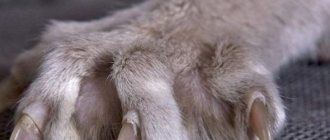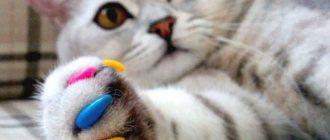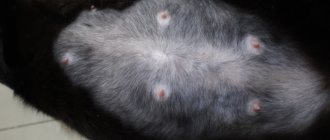Cats are affectionate and graceful animals that create coziness and a feeling of peace in the apartment. After a hard day at work, it’s nice to play with your pets or just listen to their purring. But, despite all these advantages, cats can cause a lot of trouble for humans. Their habit of sharpening their claws on the sofa can infuriate even the most loving owner. To keep upholstered furniture intact, you need to understand why the animal behaves this way and gradually wean the cat from tearing up the sofa.
Why do cats sharpen their claws?
There are many reasons explaining the natural behavior of representatives of the feline family:
- Physiology. The claws are constantly growing, and over time the old nail plate is replaced by a new, sharper and stronger one. During this, the animal experiences discomfort and inconvenience, as hangnails may form on the paws. To get rid of unpleasant sensations and to speed up the process of changing claws, cats sharpen them on what they consider to be fairly hard surfaces.
- Cats fight for territory. Veterinarians and zoologists say that the tips of a cat's paw pads contain sweat glands necessary for unique scent marks. Thus, the cat makes it clear that he is the boss here.
- This is a kind of fitness to maintain physical shape. While sharpening its claws, the cat uses many muscles, thereby subjecting them to considerable stress.
- Fighting stress. Perhaps damaged furniture and tattered wallpaper are the result of a nervous shock the cat has experienced, or he is simply trying to attract your attention.
Cats' Favorite Surfaces
Probably, upholstered furniture most often suffers from cat claws. It is not for nothing that cats choose armchairs, poufs or sofas as victims; their choice is not accidental. If the animal lives in a natural environment, the main accessory for manicure procedures is tree bark; in an apartment, the cat has no choice but to use an alternative option - upholstered furniture.
In addition, purrs do not mind testing window curtains, carpets, cabinet furniture facades, etc. for strength. There are also surfaces that cats are not interested in:
- ceramic tile;
- stone;
- plaster;
- plastic;
- linoleum;
- parquet;
- laminate and others.
Unfortunately, the materials listed are not used to make furniture, so your furnishings are still at risk. To somehow protect the upholstery or hide existing damage, you can use protective covers or restore the furniture. Next, we will talk about methods that allow you to wean a cat from tearing up furniture and are aimed at re-educating it.
Why does an animal ruin furniture?
There are several reasons why a cat scratches furniture and wallpaper. For example, this is how she performs “physical gymnastics.” By extending and retracting its claws, the pet stimulates the work of the ligaments. It also strains and stretches muscles, kneads joints.
The natural need of the feline species is to grind off the upper stratum corneum from the claws, since it will interfere with the animal’s movement and can dig into the pads on the paws.
In nature, pets do this with the help of trees, so they may mistake home furniture or wallpaper for a natural scratching post.
There are psychological reasons why a cat tears up furniture:
- Jealousy of other pets or defense of one's territory. On the surface of cats' paws there are special glands that secrete pheromones. The human sense of smell is not able to distinguish this smell, but for animals it means that the territory belongs to the creature that marked it. They can interrupt the marks of other pets with their own.
- A stressful situation in which a cat finds itself can become a reason for property damage. For example, if the animal’s owner has changed or the owner pays too little attention to the pet. Also, cats are always stressed due to moving to another place of residence or getting a new pet.
The death of the owner and his long absence from home can negatively affect the animal’s psyche, which also often serves as a reason for scratching interior items.
The reason why an animal scratches furniture is often due to age. Little kittens have not yet been trained in anything, and may simply not know that they should not tear up the sofa or wallpaper. Also, young animals are often very active and playful. They do it out of boredom, to get attention or just to get some exercise.
If you don’t teach a young pet the right place to sharpen its claws, it can get used to damaging upholstered furniture, but it’s much more difficult to wean an adult animal off.
Spray bottle in the fight against cat claws
You can try to stop your cat from scratching the sofa using a regular spray bottle filled with clean water.
It is a well-known fact that representatives of the cat breed do not like water and avoid contact with it in every possible way. This can be used in the fight to preserve the normal appearance of your apartment. As soon as the purr decides to sharpen its claws on your favorite sofa, direct a stream of water at it and thoroughly wet the scoundrel.
Advantages of the method:
- works after systematic punishment;
- does not require the purchase of special devices;
- does not come with any costs.
Minuses:
- the technique is effective only when you record the cat’s intention and immediately punish it;
- As soon as the smart cat is left unwatched, he will continue his dirty deed without delay.
Selecting the wallpaper correctly
An alternative and rather unexpected solution would be to re-glue the wallpaper in the house. There are textures that will not interest a cat due to their smoothness. Classic wallpapers often have a texture that attracts pets. The wallpaper categories below are free of this cat-attractive quality:
- Liquid wallpaper - the unusual name is explained by the unusual nature of the material itself.
This wallpaper cannot be found in roll form. Their method of application is more reminiscent of painting walls than gluing paper layers. The cellulose mixture spreads evenly over the wall and does not cause the cat to interact; Liquid wallpaper can rightly be called a new trend, capturing more and more apartments - Fiberglass wallpaper is made from glass fibers and is strong and durable.
Their main advantage is the ability to update through repeated repainting (up to 20 times). This wallpaper is not sensitive to moisture and can be washed if necessary; Fiberglass wallpaper adapts to any whim of the owner due to the possibility of repainting - Paintable wallpaper - there are special base wallpapers that allow you to apply any paint you like.
They do not have a ribbed surface or any roughness, which ensures their greater safety from cat claws; Wallpaper for painting can be either with a ribbed surface or absolutely smooth. - Vinyl wallpaper is the most affordable and simplest option of the above.
Their reliability and moisture resistance allows them to last the longest under the pressure of a cat. Vinyl wallpaper is the most traditional option, gaining popularity due to its quality
Cats don't like strong scents - we use this against them
If spraying with cold water does not bring results, you need to look for a new effective method that will help bring some sense to the animal. Many breeders use scents in this matter, for example, a bright citrus aroma.
In some cases, it is enough to put a slice of lemon next to your favorite place for manicure and the cat will not repeat his old mistakes for a long time, leaving his favorite carpet alone. You can use citrus essential oils, but under no circumstances apply them to the damaged area, so that you don’t have to figure out how to remove the resulting stains. Specialized veterinary stores have special repellent sprays and fumigators:
Pros:
- efficiency 99.9%.
Minuses:
- aroma traps will have to be constantly updated, since natural odors quickly disappear.
What should I do to prevent my cat from tearing up the wallpaper?
What to do if a cat tears up the wallpaper? Cats are predators by nature, and their claws are their natural “weapons.” Therefore, since ancient times, cats regularly sharpen their claws to keep them strong and healthy.
Unfortunately, cats love to sharpen their claws on almost everything that takes their fancy. Your beautiful wallpaper may also be damaged. Why does a cat tear up wallpaper?
- Firstly, they love to sharpen their nails to their full length, and wallpaper is a great option.
- Secondly, cats like materials that tear easily.
It's a pity, but wallpaper is exactly that. Do not despair if an ordinary curse did not succeed in weaning your cat from this bad habit. Better try the following recommendations:
- To get started, buy your pet a scratching post or make one yourself. Use the same carpet or wallpaper as a material for “scratching”, and the cat will love to sharpen its claws here.
- Place the scratching post near the place where the cat has already scratched the wallpaper.
- It is also advisable to place the scratching post near the place where the kitty likes to sleep.
- Spray the area where your cat constantly scratches with a special spray made from orange peels. You can make your own solution with orange essential oil.
Scotch tape will help preserve furniture
If for some reason the previous two methods did not work or did not suit you, try retraining the cat using regular double-sided tape.
The fact is that cats really don’t like it when their paws stick to something, so they won’t sharpen their claws on a sticky surface. To test this method in practice, stick a sufficient amount of tape to the damaged side of the furniture, curtain, or window sill.
Pros:
- the cat will not want to deal with the unpleasant sticky surface and will lose interest in it;
Minuses:
- Because of the sticky tape, the interior will, of course, not benefit; you will have to endure some inconveniences until the bad habit is eradicated.
Personal space
When buying an apartment, a person equips it according to his needs and desires. But what about the cat? Sometimes, when welcoming a kitten into the family, the new owner does not make any changes to the layout of the house, with the exception of placing a tray and bowls for food and water. If you are one of these owners, then you should not be surprised that the cat is looking for something to do in places that are not suitable for it - it simply does not have “its own” place.
In a perfectly sterile apartment, it will be very difficult for a cat to find a place for itself.
Apartment arrangement
It is recommended to arrange several interactive corners in your apartment or house before purchasing a pet (their number and size will depend on the size of the room). Play areas allow the cat to realize a number of hunting and territorial instincts, which the owner seeks to avoid a destructive encounter with. If you prohibit your cat from approaching the wallpaper and in return provide him with a number of other interesting things (such as a scratching post), sooner or later the pet will switch his attention.
The presence of interactive zones will quickly switch the pet’s attention from the wallpaper that is dear to the owner
The play area can be purchased ready-made or built independently. Some owners use a trick and build an interactive platform for the cat into existing items. For example, they wrap the legs of a coffee table with felt, creating an impromptu scratching post.
Complete set of gaming complexes
Specialized areas for cats, as a rule, consist of several differently grouped parts:
- A closed house in which the pet can rest from the events around it;
- Tall poles covered with felt, designed for grinding down claws;
- Elevating platforms that satisfy one of the cat’s main needs - to look around the entire territory entrusted to him at one glance;
- Small interactive details, in the form of dangling soft balls, which your pet will spend many hours trying to catch.
There are many inventive options for adapting complexes to different types of housing
Trimming or declawing
You can get your favorite furry manicure done at a pet beauty salon, use the services of a groomer or veterinarian, or try to master a simple procedure yourself at home. For this you will need a nail clipper.
One of the simplest answers to the question of how to stop a cat from scratching furniture with its claws is help with manicure. If you decide to carry out the manipulation yourself, be patient, ask someone to hold the animal, act with extreme caution so as not to injure the delicate skin of the pet.
Those who have repeatedly unsuccessfully tried to wean a cat from the harmful habit of ruining an apartment often use a drastic remedy to prevent the cat from tearing up the furniture - declawing. From a common sense point of view, this is a barbaric procedure, as a result of which your animal will lose an important part of its body, will not be able to walk outside, will not be able to protect itself from the enemy and will be forced to go through a long rehabilitation period.
Effective ways
It is not easy to stop a cat from tearing furniture and wallpaper if it has already become a habit. Some owners prefer to change the type of wall and floor coverings. For example, cats are indifferent to plastic panels, ceramic and PVC tiles, high-class laminate, artificial stone and decorative plaster.
Some people prefer to cover upholstered furniture with thick fabric upholstery.
However, we must understand that even replacing the coating or an alternative to it will not be able to permanently wean the cat from scratching its claws and gnawing objects. This process is natural and vital. Therefore, you will have to not only wean yourself off, but also think about how to switch your attention to other subjects.
Let's consider the most effective methods of protection.
Repellent odors
You can try to wean your pet from a bad habit by treating his favorite scratching areas with a product with an unpleasant aroma. It is known that cats do not like the citrus smell, so this is worth taking advantage of.
This can be orange, lemon peel or essential oil.
However, oil is inconvenient because it leaves unsightly greasy stains on the surface. An alternative to citrus, ether or spray can be some spices (for example, coriander or chili), which can be used to treat some surfaces (not suitable for furniture on which a person sits).
Protective coatings
You can save the upholstery of a sofa and armchairs by using covers made of special fabric or so-called anti-vandal Euro covers. In specialized stores you can choose options with a coating that is too tough for cats and not for their claws.
They simply will not be able to stick their claws into the fabric.
Trimming and nail trims
You can stop your cat from scratching the upholstery and damaging the surface of the wallpaper in a more effective way by cutting the claws or gluing special plastic covers on them. To trim claws, purchase a special device - a nail clipper, literally cutting off 1-1.5 mm of the regrown length.
The device is quite convenient and allows you not to stretch out the procedure, and therefore the cat does not have time to get nervous.
The pads are put directly on the claws, having previously lubricated them inside with special glue. Don't worry too much about it being harmful. As practice shows, the glue is not so strong, but for some time the cat will not be able to damage the furniture upholstery and wallpaper.
Alas, at the same time she will not be able to retract her claws, and it will be difficult for her to jump, but she will still be able to provide temporary protection to objects.
Pulverizers and sprays
To prevent your cat from sharpening its claws and teeth on furniture, wallpaper and curtains, you can try using a spray bottle. Scaring can have an effect on individual individuals if it is done at the moment when the animal is tearing upholstery fabric or wallpaper.
You can also spray your favorite items with a special spray to repel your pet. Citrus-scented sprays are repulsive to some cats.
Available means
You can protect furniture and wallpaper using another method. For example, favorite places can be covered with sticky, sliding or rustling material on top. For example, stick double-sided tape or foil to the torn area of the wall.
Some people prefer to create a scaring noise when the cat sharpens its claws. To do this, use baby rattles or a bunch of keys.
scratching post
A special device for sharpening claws is an excellent and effective way to save both furniture and wall cladding. It can be either an individual item or part of a play complex for a cat. Its shape can be very diverse, as well as its material.
Cats like large play complexes, because this is their territory where they can spend a lot of time. And this allows you to save the owners’ upholstered furniture.
Equipment for a personal sleeping area
To prevent your cat from tearing up furniture and wallpaper, it is recommended to make a personal place for him to sleep. This will reduce the animal's stress if people have multiple pets. You can use special houses, sun loungers or ordinary cardboard boxes.
You need to choose a suitable space for installation and accustom the cat to it using training or aromatic substances (mint, valerian).
It is recommended to place the pet's house near a place where people are often present, since cats love company and rarely tolerate loneliness. It is necessary to wean other animals from trying to occupy someone else's house and equip a separate one for each.
This will reduce the number of stressful situations for cats and help prevent property damage.
Wallpaper protection
If an animal scratches wallpaper or furniture in one place, then you should get fabric covers. They are easy to attach to the surface using nails, glue, and paper clips. The damaged area can be covered with adhesive tape. It is subtle, but effective against cats, as they really don’t like it when something sticks to them.
You can also use a woven cotton rug that is attached to a wall or furniture. It, like fabric, will allow your pet to sharpen its claws without damaging interior items.
It is recommended to choose liquid, slippery wallpaper or replace old ones with them. This way, the cat will have nothing to cling to, and it will stop tearing at the wall. The most drastic solution may be to cover the damaged areas with tiles or decorative plaster.
If all else fails
If water and a scratching post do not solve the problem, you will have to think about how to stop your cat from scratching furniture, using more serious methods. You can use special silicone attachments for animals. They are attached to the claws with an adhesive substance and last from 1 to 2 months. After the upper horny part of the cat's toe peels off, the pad falls off along with it.
An alternative to silicone devices is surgical declawing. This procedure is not recommended for use as it is similar to amputating a human finger and is not humane.
You can also protect items from the kitten using covers. They are similar to fabric covers that are attached to the surface, but cover the entire furniture or a separate part of it. If a cat is tearing at an element of the interior, it is recommended to use a spray with a strong repulsive odor.
You can find it at a veterinary pharmacy or prepare it yourself.
This substance has an unpleasant aroma for cats and can discourage the animal from any furniture. You can mix essential oils, spices, citrus juice with water, or hang bags of spices near the problem area.
This method is not always suitable, since the listed substances emit an unpleasant aroma for humans and can also leave streaks and stains.
Install a scratching post at home
To preserve the original appearance of upholstered furniture, manufacturers of veterinary products have come up with special scratching posts that purrs can use for their intended purpose, without fear of being punished. Veterinarians and breeders recommend accustoming your kitten to a useful device from childhood, so you can be sure that the sofa and other upholstered furniture will definitely not interest the fluffy one.
The choice of scratching posts in the pet store is huge:
- in the form of a house or play complex;
- corners for protecting corners of furniture, connecting walls;
- in the form of a straight board, wave;
- in the form of a column.
These can be floor or wall structures, simplified products in the form of fabric-upholstered boards, or multifunctional houses with a sleeping area and several play compartments. Scratching posts are made from different materials; sesal, jute, natural wood, and carpet are used in production. Whatever option you choose, the main thing is to accustom the cat to it as early as possible. This can be achieved by using a variety of treats to attract attention, including catnip treats.
You can also apply special products to the surface of the scratching post to correct the behavior of the fluffy.
A scratching post is the best device
A great way to save your favorite items is a scratching post. With its help, you can save wallpaper and furniture without harming your pet. Moreover, now you can find a scratching post for every taste and color: from the simplest to the most intricate, built into a house on several floors. The materials are also different and your pet will find one that will impress him more than expensive coatings.
The shapes also differ: vertical, horizontal, inclined. To begin with, it is worth proceeding from financial capabilities and taking into account the material of manufacture. Observe what your animal likes to scratch the most.
It would be good to install the scratching post in your pet’s favorite place and secure it well. Everything should be as comfortable and pleasant as possible so that the animal likes it.
What you should pay attention to:
- Cats usually sharpen their claws after waking up, so it is best to place the scratching post near their sleeping area.
- You should spray it with a spray that arouses interest among animals, or tie a toy there.
- After the scratching post is installed, keep an eye on the cat. As she sharpens her claws in the right place, give her a treat.
- If you suddenly find an animal doing leprosy, do not scold it, but take it to the scratching post.
- Claws must be trimmed very carefully. You should buy a special nail clipper in the store and cut only the light part of the nail. Do not touch a blood vessel under any circumstances, otherwise your pet will never let you near its claws again.
- If the cat continues to damage wallpaper and furniture after the scratching post, then immediately after the crime, scare it.
- After purchasing a scratching post, try to save your favorite places with tape, foil, and sandpaper. Create the most inconvenient conditions for sharpening claws in places that are inconvenient for you.
How to stop your cat from scratching furniture using alternative methods
If you have tried all of the listed methods in your arsenal and none of them have proven effective, you need to try alternative methods of combating a bad cat habit:
- Try putting special anti-scratch guards on the cunning pest's claws. Each claw is fitted with a silicone attachment, which is attached to the surface of the claw with glue, which prevents accidental removal of the accessory.
- Furniture covers. To protect your favorite bed, new sofa or comfortable chair in which you like to drink hot tea and watch the evening news from the merciless claws, you can buy protective furniture covers, the material of which will not be of interest to the four-legged pest.
- Considering that cats choose only certain materials for sharpening their claws, you can replace the damaged material with something that will not arouse the purr's interest. So, in place of the destroyed wallpaper, you can put tiles or cover it with plastic panels.
- Try not to leave your cat alone with an object that she mistook for a scratching post; raising pets has not yet been canceled.
Unlike surgical declawing, the pet does not experience pain or significant discomfort, quickly gets used to the changes and eventually stops paying attention to the attachments. The only thing a cat with such a manicure cannot do is jump to a considerable height and damage your furniture, which means that the goal can be considered achieved. After the claws grow back, you will have to repeat the procedure of gluing new pads.
What to do if a cat scratches a leather sofa?
If time has been lost and the cat has thoroughly torn up the furniture upholstered in fabric, restoring a specific area using the same material or an original decorative insert can help. A leather sofa cannot be restored so easily; you can only mask shallow scratches on your own. In case of serious damage, it is better not to try to do anything at home, but to immediately contact a professional.
- Olive oil. The use of this component can save, even if the animal prefers to sharpen its claws on light skin. It is first recommended to test the method on an inconspicuous area of the material and only then begin restoration. Take slightly warm olive oil and a thick cotton pad. We soak the cotton wool in the oil, squeeze it out thoroughly, and gently wipe the scratch itself and small areas of skin around it. We work in a circular motion in one direction. After this, we wait until the composition dries and evaluate the work. In some cases, a scratch may disappear without leaving a trace after just one treatment. If necessary, repeat the manipulation.
- If a cat slightly scratches a dark leather sofa, it is better to use shoe polish. We select the product of the required shade, apply it to a cotton swab and carefully rub it into the damaged surface. We wait until the mixture dries and wipe the area with a clean paper napkin. We evaluate the work and, if necessary, make several more approaches.
- If the furniture is covered with deep scratches, you will have to do the following. We use the oil approach first (regardless of the color of the material). Then we treat the area with oil again, put a cotton cloth on it and wait for the liquid to be absorbed into it. After this, we take a new piece of fabric, moisten it with water and apply it to the damaged area. Iron the flap with a warm iron, holding it for no more than 8-10 seconds. If necessary, repeat several times. From this effect, the oil will be absorbed better, masking the scratches.
The sooner you start implementing the above methods, the greater the chances of saving the furniture without sacrificing the health and good mood of your pet.
We recommend reading the article on how to stop a cat from scratching wallpaper
General tips or how to stop a cat from tearing up furniture
Do not forget that representatives of the cat family are very smart and resourceful. To retrain an animal, you will have to “have a heart-to-heart talk with it,” be affectionate and attentive, carefully pointing out errors in behavior.
Aggression and physical punishment do not lead to a positive result; it causes stress in the pet and only aggravates the situation. As for education, you need to adhere to the following principles:
- make sure that the cat does not experience stress, surround it with love and sincere care;
- set the boundaries of what is permitted and do not allow them to be crossed;
- Do not hit a defenseless animal, this is a form of cruelty and is absolutely unacceptable.
We talked about how to wean a cat from tearing up a sofa and other interior items, and dwelled in detail on popular methods of combating a bad habit. You just have to choose which of these options you will use.
Check out the toys, teasers, and treats that will keep your furry pets occupied:
Why does the cat tear off the wallpaper?
Cat owners often have to deal with the fact that their pet has torn up furniture, wooden doors, curtains, and corners of walls with wallpaper. The reason for such actions is the physiology of cats. But sometimes a pet commits petty hooliganism when it is angry, anxious, jealous, or wants to attract the attention of its owner. If you don’t raise a kitten and don’t play with it, the fluffy one will also spoil all the things around it due to boredom and ignorance of the rules of behavior. It will be difficult to wean an adult pet from tearing wallpaper.
Psychological reasons
Cats are highly sensitive and difficult to perceive change, no matter what breed they have. Moving to new places, a long absence of the owner or a change of family provokes changes in the behavior of the animal. To get rid of nervous tension, the cat jumps on the walls and starts scratching the sofa. If the pet is driven away, it arches its back in displeasure and hisses. The appearance of a new four-legged friend or child in the house makes the cat jealous. To attract attention, she peels off the wallpaper and misbehaves. When a cat senses the presence of another animal, in this way he tries to declare his dominance over the territory.
Physiological factors
With the help of such actions, the animal grinds off the keratinized layer of overgrown claws.
As the claws grow, they peel off and become a nuisance for the cat. Therefore, the animal is looking for a way to get rid of the discomfort and itching. When the claws point, the dead scales fall off. When a cat sharpens its claws, it stretches to its full height. At the same time, the muscles of the back and neck are warmed up. There are glands on the paw pads that produce an odorous fluid. By peeling wallpaper and furniture, the pet leaves its “trace” there and, thus, marks the territory. Although domestic cats do not hunt, they instinctively continue to sharpen their claws.
Behavior problems
It is necessary to instill in your pet the necessary skills and accustom him to the rules of behavior from childhood. When an adult cat tears wallpaper and scratches furniture, it is much more difficult to correct the situation. If the owner is indifferent to the fact that the kitten is damaging the walls or sofa several times, this habit will become ingrained. Negligence in care and lack of attention are reflected in the behavior of the pet. Some cat breeds have genetic memory and are prone to good manners. A kitten that comes from a shelter or was picked up on the street will require patience in training.











